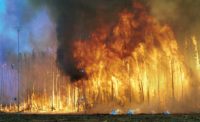
As the King Fire, which has burned through 97,000 acres of California's Sierra Nevada mountains, started to threaten electricity and generating stations that provide power to Sacramento, late September rains helped avert a potential public emergency.
The fire, which started on Sept. 13, was about 90% contained on Sept. 29, after burning a dozen homes and 68 minor structures. "We've been told that the perimeter of the fire will not spread farther and that [isolated] hot spots are the focus of firefighters now," says Einar Maisch, director of strategic affairs, Placer County Water Agency (PCWA). Wayne Allen Huntsman, a 37-year-old construction worker from Santa Cruz, faces felony arson charges. He is in the El Dorado County Jail under $10 million bail.
PCWA has 224 MW of electricity generation in the area, but only 17 MW of capacity was shut down because of a downed Pacific Gas and Electric power line, which carries electricity from the utility's French Meadows substation. "The rest of our generation capabilities were unaffected. We made the firefighters aware of what facilities were threatened, and our powerhouse was protected," Maisch says.
In a neighboring county, the El Dorado Irrigation District's (EDID) construction season was pressured by the fire, but work will start as scheduled in the first week of October, said EDID spokeswoman Mary Lynn Carlton. "We have a very old system—built in the 1850s—and we have a 'sections' project in which we take part of it out of service to make upgrades and repairs every year. Part of the system had to be shut down earlier than usual because of the fire, but we expect construction to start on time."
When the fire started, it was dangerously close to the penstock that delivers water to EDID's hydroelectric generator and a network of wooden flumes that move water through the area. "We had close to 9,500 firefighters here in Placerville that helped control the main threat," Carlton says. "We were very fortunate."
The Sacramento Municipal Utility District (SMUD) de-energized lines from the Sierra Nevada network of reservoirs and powerplants, but the utility was able to source supplies from other stations for its customers. "Firefighters did not want those lines live while they battled the fire," says Scott Flake, power-generation coordinator for SMUD. "Other than that, our facilities were largely undamaged because of the vegetation management program we have in place that cleared rights-of-way near our power stations and lines. These programs helped keep the damage to a minimum. Saturday afternoon, we were able to reenergize the lines."
At a site also in the path of the fire, SMUD is developing a 400-MW pumped storage project. The project site was unaffected by the fire.

